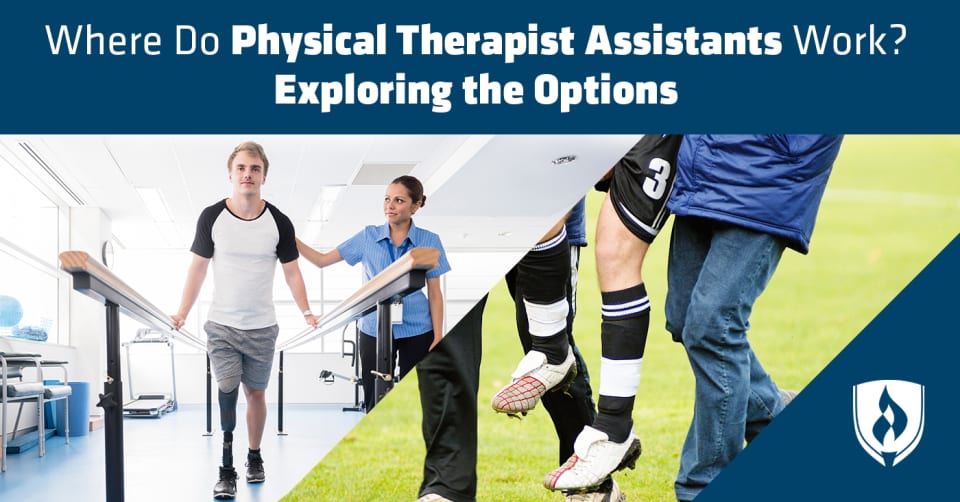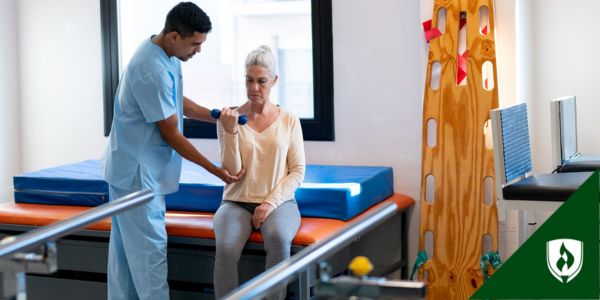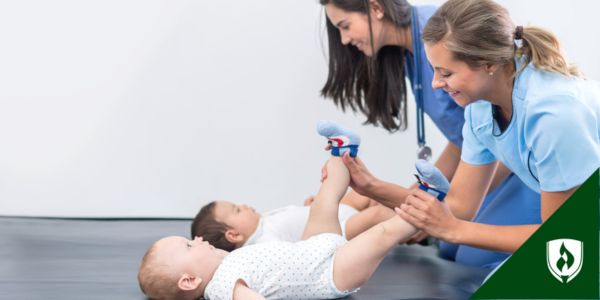
You’ve always wanted a job that focuses on helping people. With the strength of the healthcare sector these days, there are more than just a few options for you to consider. If the idea of nursing and medical care feels a little too, well, medical for you, and teaching or coaching hasn’t felt quite right either, rest assured—there are other career paths you can follow.
The role of a physical therapist assistant (PTA) might be completely new to you, but it could also be exactly what you’re seeking. With an emphasis on holistic methods, PTAs use exercise, movement and a detailed understanding of the human body to help patients reduce pain and gain mobility. PTAs get to teach patients how to properly care for their body and heal from a particular ailment and oftentimes, they do many of the exercises with the patient.
The projected outlook for this career is bright. Employment of physical therapist assistants is expected to grow 31 percent through 2026, according to the Bureau of Labor Statistics (BLS).1 This is more than four times faster than the projected national average growth rate of 7 percent for all occupations.1
But where do physical therapist assistants actually work? It turns out these professionals are employed in a variety of environments. Keep reading to discover the diverse array of options out there.
9 Areas you’ll find physical therapist assistants working
If you’re intrigued at the idea of working as a physical therapist assistant, you’re probably curious about where you might be working. Let’s learn more about nine different PTA work environments.
1. Physical and occupational therapy offices
Known as outpatient clinics, this is perhaps one of the more popular routes for physical therapists and PTAs alike. Many physical and occupational therapy offices are private practices that specialize specifically in physical therapy or a certain kind of physical therapy. Doctors will often refer patients to a specific physical therapy clinic if they think that a more focused rehabilitation program is necessary. These clinics are stocked with all of the exercise, testing and therapy equipment required to help patients heal quickly and safely.
PTAs will assist physical therapists in helping patients with particular movements or exercises. Many physical therapy movements require heavy lifting and adjusting of a patient, so PTAs also aid in assisting physical therapists with elevating and hoisting patients in an effort to limit the risk of injury.
“An outpatient setting like this has the most regimented schedule of physical therapy environments,” explains physical therapist Tonya Olson. “The environment itself tends to be more fast-paced. You need to be adaptable because, as a PTA, you might be working with a variety different physical therapists and a mixed bag of patients.”
2. Hospitals and doctors’ offices
Physical therapy options are a popular route for healing, and hospitals are eager to staff their physical therapy environments. Some hospitals and doctors’ offices staff their own physical therapists and physical therapist assistants to help patients reintegrate normal movements into daily life after certain procedures or surgeries.
Within a hospital setting, a physical therapist assistant will assist patients as they recover from an illness, accident, surgery or trauma. The objective is to help patients in rehabilitation until they are well enough to be discharged safely.
“In a hospital, the PTA tends to have a little more independence,” Olson says. “The patients are sicker and more acute in their illnesses, so the interventions are going to be simpler: helping them out of bed or helping them move from the bed to the toilet. You’ll also be working closely with the nursing staff and oftentimes consulting with the physical therapist.”
3. Nursing homes or extended care facilities
In a nursing home setting, most of those admitted are long-term patients. PTAs help provide rehabilitation and other services to residents and typically care for elderly tenants. As the baby boomer population ages, more nursing homes and extended care facilities will be in need of PTAs to aid in therapy programs and assist patients.
“Skilled nursing home facilities require a significant amount of autonomy for a PTA,” Olson says. “You need to be independent thinking, as PTAs are the workhorses of the facility and often coordinate with certified nursing assistants (CNAs).”
She adds that this setting allows PTAs to work with a broader scope of practice because they are much more independent. In an extended care facility, it’s general practice that the physical therapist needs to be physically on site but not necessarily interacting with the PTA.
4. Home healthcare services
While the majority of residents in home healthcare settings are elderly, there are also pediatric patients with developmental disabilities or other issues, as well as other types of patients who are recovering from an injury or illness. As a PTA providing home healthcare services, your work environment is the patient’s own residence. This kind of setting also includes group homes, residential facilities or certain types of hospice locations.
This is the setting in which PTAs experience the most independence, according to Olson. “You’re driving on your own, and you’re really setting your own schedule,” she explains. “You have the freedom to arrange your day according to what works best for you, and the PT is just a phone call away.”
The great thing about this type of setting is that it changes every day. You’ll be assisting patients in the comfort of their own homes and you’ll get some exciting variety within your workday.
5. Schools
If you like working with kids and teens, you’ll be happy to hear that many schools hire on-site physical therapy assistants to provide care in an educational setting.
PTAs in this environment often may work with children with special needs, including autism, developmental delay and neurologic injury, among other conditions, according to Boguslawa Badon, a licensed physical therapist and owner of Farmington Valley Physical Therapy. “Physical therapy assistants may also work with sports teams to continue their rehab programs at school after they’ve had their PT evaluation, rather than having them travel to the clinic and miss time from school or practice,” Badon adds.
Whether a student gets injured during gym class or you’re working with an athletic team to educate them on preventing injuries, there are a good variety of job duties for PTAs who work in schools.
6. Sports facilities and fitness centers
The focus is on wellness when PTAs work in a sports facility or fitness center. There are a variety of sports-related injuries that PTAs can help athletes overcome. Physical therapy support is also often provided to help prevent such injuries and illnesses from occurring in the first place.
“Some [fitness centers] will go as far as pre-rehabilitation, or pre-hab for short, to optimize a client’s range of motion or strength before they undergo a procedure or surgery,” Badon says. “Many times clients are paying for these services out of pocket rather than going through their insurance companies.”
Promoting a healthy lifestyle is a key goal for PTAs in fitness centers, as opposed to treating a problem after the fact. Whether you work in a sports training facility, a privately owned fitness center or a franchise fitness center, if you love athletics and working out, this might be a great fit for your future as a PTA.
7. Across the country
Yes, yes, we know this isn’t a specific setting—but hear us out. Physical therapist assistants can elect to pursue contract work in hospitals, clinics, fitness facilities and schools around the country by taking a travel PTA job. Travel PTA jobs are perfect for new grads who want diverse experiences and variety in their work. Most contract travel PTA jobs last anywhere from six weeks to six months if needed. These needs are usually immediate, so travel PTAs don’t start looking for a new role until about two weeks before they hope to start.
Often these quick transitions are made easier by housing stipends and incidental pay for other costs, usually including a tax-free per diem to pay for the expenses associated with living out of town while maintaining a residence back home while on assignment. Plus, the pay for travel PTA positions, though hourly, tends to be higher than permanent PTA positions, according to Amy Garrigues, PT, DPT and executive director of the Rasmussen University Physical Therapist Assistant program.
“The benefits of becoming a traveling PTA are countless,” says Meredith Castin of The Non-Clinical PT, “You’ll build a network across the country exploring new patient populations and roles.”
Garrigues says working as a travel PTA provides opportunities to work in a huge variety of specialties including acute care, inpatient rehabilitation, skilled nursing, outpatient care and orthopedics. By becoming a travel PTA early in your career, you’ll learn what kind of work is most meaningful to you while connecting with people that can help you get there.
Plus, you’ll get to travel! These positions give you a unique opportunity to visit areas you’ve never seen and meet people you’d otherwise never come into contact with—a valuable experience on its own.
8. In research
PTAs are naturally curious people so it makes sense that some might thrive working for organizations that conduct research. When new treatments or medical devices related to physical therapy are being developed, they need to undergo clinical trials and studies to prove their effectiveness and safety. PTAs can assist in this research by helping to collect data, analyze results and recruit study subjects, according to Castin.
Though formal research PTA positions like these are not frequently posted, you don’t have to work at a research university to satisfy your inquisitiveness. “Generally, if you’re willing to take initiative, there are all sorts of opportunities to get involved with research efforts, regardless of where you work,” says Castin.
9. For the government
Though the scope of practice for PTAs is very similar for both government-employed and privately-employed PTAs, there are benefits to pursuing government work, says Garrigues. For example, working for a veteran’s hospital can be a rewarding experience—you get to rehabilitate the people who’ve put their well-being at risk for your country. Plus, with 1,243 veteran’s healthcare facilities, including 170 VA Medical Centers, you’ll find plenty of variety in settings where you can work.
PTAs can also find work in the U.S. military, with all major branches needing qualified PTAs to assist in rehabilitation. It’s important to note these roles have slight differences in what they’re called compared to their civilian counterparts—Physical Medicine Apprentice for the U.S. Air Force, Physical Therapy Specialist for the U.S. Army and Physical Therapy Technician for the U.S. Navy. While these roles will definitely be a change of pace from civilian PTA work, the benefits of working for the military may be appealing.
An array of options
So where do physical therapist assistants work? Now you know that there’s not a single setting. If you’re looking to work in more of a medical setting, a fitness setting or school setting, there’s a place for you in the growing field of physical therapy.
If you’re intrigued by the options you’ve read about above, learn more about what you’ll need to get started in a PTA career by checking out our article “How to Become a Physical Therapist Assistant (and Why You Shouldn’t Hesitate!)”
Related Articles:
1Bureau of Labor Statistics, U.S. Department of Labor, Occupational Outlook Handbook, [accessed March, 2019] www.bls.gov/ooh/. Information represents national, averaged data for the occupations listed and includes workers at all levels of education and experience. Employment conditions in your area may vary.
EDITOR’S NOTE: This article was originally written in 2017. It has since been updated to include information relevant to 2019. Insight from Olsen and Badon remains from original article.




